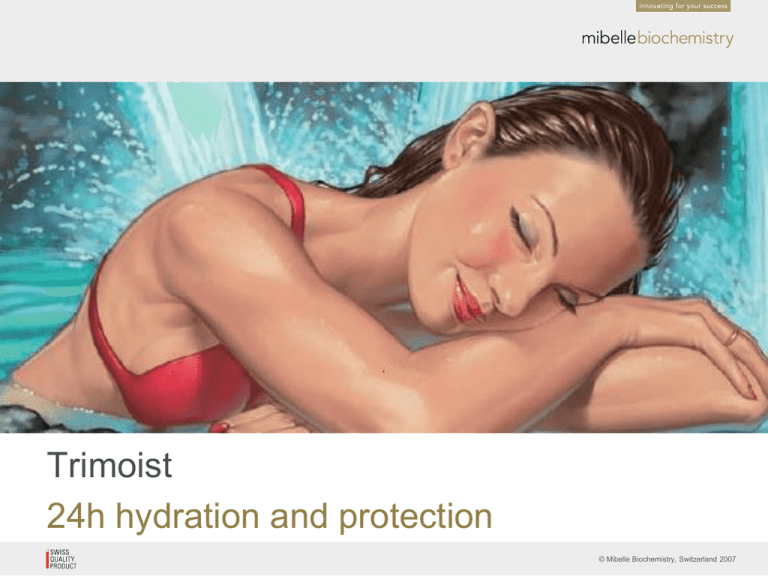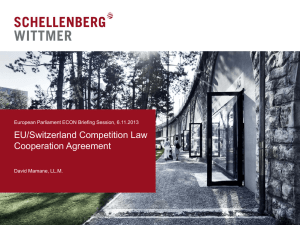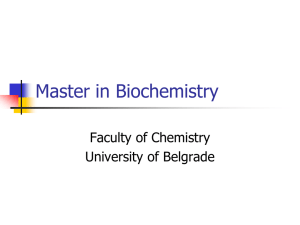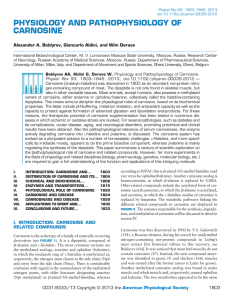Trimoist - Body Cosmetic
advertisement

Trimoist 24h hydration and protection © Mibelle Biochemistry, Switzerland 2007 Concept of the Moisture Balance Theory Hydrolipid film Brick and mortar model Protecting film water water skin Trimoist NMF lamellar lipids humectants © Mibelle Biochemistry, Switzerland 2007 Structure of the Skin protecting film lamellar lipid barrier humectants © Mibelle Biochemistry, Switzerland 2007 Structure of the Skin Stratum corneum Corneocytes Intercellular space Lipids Aqueous space Lipid layer Ceramides Phospholipids Triglycerides Fatty acids Cholesterol © Mibelle Biochemistry, Switzerland 2007 Protein-Glycation frying, baking, roasting skin Maillard-Reaction Protein glycation Non-enzymatic interaction of sugars and proteins at high temperatures or over a long time Collagen and elastin react with sugars -> AGEs (advanced glycation endproducts) Brown color Loss of elasticty, dull and wrinkled skin © Mibelle Biochemistry, Switzerland 2007 Result of Skin Glycation • Irreversible cross-links between adjacent protein molecules • Cross-linking significantly contributes to the stiffening and loss of elasticity found in aged tissues © Mibelle Biochemistry, Switzerland 2007 Formation of AGE's Collagen Collagen fibre Cross-linked and stiffened collagen Sugar Carnosine With Carnosine: Collagen fibers are protected and stay elastic © Mibelle Biochemistry, Switzerland 2007 Glycation and Diabetes People with diabetes, who have high glucose levels, show accelerated aging. Results already in young people: • stiffening connective tissue (collagen) • hardened arteries • clouded eyes • loss of nerve function • less efficient kidneys © Mibelle Biochemistry, Switzerland 2007 Formation of AGEs O C O (C HOH)4 A m adori pro duct protein Schiff base NH2 NH NH CH CH2 (C HOH)4 C + CH2 OH glucose CH2 O H O (CHO H)3 CH2 OH advanced glycation end products COO H Arginine C H2 NH N (CH2 )4 O NH CH CML C Lysine N N H + N N+ N Lysine Lysine pentosidine M O LD © Mibelle Biochemistry, Switzerland 2007 Anti-Glycation H N H N N Carnosine O C HO NH2 O • naturally occurring • a peptide-like compound with a free amino group • reacts with the aldehyde or ketone group of reducing sugars Competitive inhibitor of AGE's © Mibelle Biochemistry, Switzerland 2007 Carnosine Prevents Formation of MDA UV-A Lipidperoxidation Malondialdehyde (MDA) Carnosine Protein carbonylation, AGE formation © Mibelle Biochemistry, Switzerland 2007 Active factors in Trimoist 1 Protecting film • CM-Glucan Protecting film, improves skin elasticity, stimulates self protecting capacity of the skin 2 Lamellar lipid structur • • • • • Form a basic lamellar lipid structure in water Stearyl lactate Cetyl alcohol Oleic acid triglyceride Phytosterols Vitamin EAcetate Enhance the barrier function of the lamellar lipid layer 3 Humectants • Glycerin • Lactate Bind high levels of water + Anti-Glycation • Carnosine Reacts with reducting sugars and thus inhibits formation of AGEs © Mibelle Biochemistry, Switzerland 2007 Increase in Skin Hydration 5% Hygroplex 5% Trimoist 20.00 Increase in skin hydration (%) 16.00 12.00 8.00 4.00 S-054 0.00 after 3 days after 5 days © Mibelle Biochemistry, Switzerland 2007 Increase in Skin Firmness 5% Hygroplex 5% Trimoist 35.00 Increase in skin firmness (%) 30.00 25.00 20.00 15.00 10.00 5.00 S-054 0.00 after 3 days after 5 days © Mibelle Biochemistry, Switzerland 2007 Increase in Skin Smoothness 5% Hygroplex 5% Trimoist 8.00 Increase in skin smoothness (%) 7.00 6.00 5.00 4.00 3.00 2.00 1.00 S-054 0.00 after 3 days after 5 days © Mibelle Biochemistry, Switzerland 2007 Increase in Skin Hydration 18 Increase in skin hydration [%] 16 14 12 10 8 6 Hydrogel + 1% Trimoist 4 Hydrogel + 2% Trimoist Hydrogel + 5% Trimoist 2 S-058 0 7 days Hydrogel + 5% Hygroplex 14 days © Mibelle Biochemistry, Switzerland 2007 24 h hydration effect 65 untreated * 60 * * moisture[a. u.] 55 * emulsionwith 2% Trimoist * 50 * 45 40 35 30 25 S-063 20 0 2 4 6 8 12 24 hours after application *p<0.05 versusuntreated © Mibelle Biochemistry, Switzerland 2007 Benefits for R & D Staff 1. Trimoist is an active suitable for a great variety of cosmetic topics: - Moisturizing - Anti-Aging - Firmness - Protection - Anti-Glycation 2. Trimoist in an active containing a large number of up-to date ingredients: - lamellar lipids - NMF/Humectants - Protecting Polysaccharide - Phytosterols - Dipeptide (Carnosine) © Mibelle Biochemistry, Switzerland 2007 Benefits for R & D Staff 3. Trimoist in an active documented with a large number of dermatological studies : - Skin Hydration - Skin Elasticity - Skin Smoothing - Film Protection - Anti-Glycation - Skin Regeneration - Antioxidant Status - Protection against oxidative stress © Mibelle Biochemistry, Switzerland 2007 Résumé Trimoist- the 3-step moisturizing system supports all three elements of the skin's own moisture balance system: 1. Protecting film CM-Glucan enhances the skin's own defence system and builds a superior protecting film. 2. Lamellar Lipid barrier Skin-like Lamellar Lipids enhance the barrier function of the lipid layer in the epidermis to boost the moisture barrier. 3. Humectants Glycerin and Lactate mimic the Natural Moisturizing Factor (NMF) of the skin to provide an instant burst of hydration. Carnosine prevents the cross-linking and stiffening of collagen by glycation - the technical term for the process that leads to a loss of skin-elasticity © Mibelle Biochemistry, Switzerland 2007 Trimoist Hydrate and protect your skin with the 3-Step Moisturizing System of Trimoist… …keeps skin at its best: softer, smoother, even-toned, visibly less lined. © Mibelle Biochemistry, Switzerland 2007 CM-Glucan: Photo Protection 7 Squalene peroxides [units CL] 6 5 4 3 2 1 0 nt nt 0% 0,04% 0,2% CM-Glucan in o/w emulsions nt UV-A 10 J/cm 2 © Mibelle Biochemistry, Switzerland 2007 CM-Glucan: Film Protection 80 Protection relative to untreated skin [%] Skin humidity 60 40 20 0 0% 0.1% hydrogel 0.4% o/w 0.04% 0% emulsion CM-Glucan © Mibelle Biochemistry, Switzerland 2007






